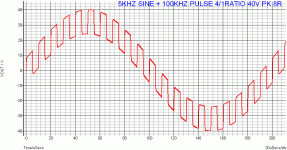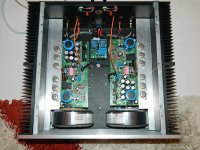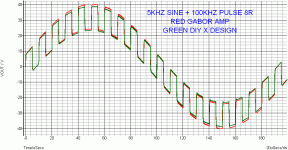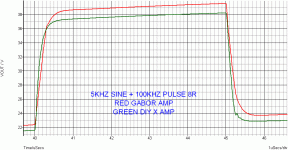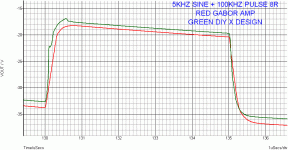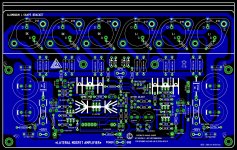I have used the 649/669 in a few amplifiers.
I like what I see and hear.
None were original Hitachi, all were a second source copy.
I have no way of testing the various parameters to see how close they are to the Hitachi?
These do have a super SOA that few other drivers can match.
And those that better them, are specified at only 20% of the fT.
I like what I see and hear.
None were original Hitachi, all were a second source copy.
I have no way of testing the various parameters to see how close they are to the Hitachi?
These do have a super SOA that few other drivers can match.
And those that better them, are specified at only 20% of the fT.
Hello
wahab I have a question to you
I have 10pair Hitachi 2SB649A/2SD669A C type at home. Can I use those some place in these amplifier for cascode etc?
http://ampslab.com/Freewares/2sb649a.pdf
It look like not bad transistor (to me better than BF)
In case you would advise not to use them not a problem!
For VAS I'll buy the best, I didn't had time to look around here in Toronto at the local store until now.
Greetings Gabor
Hi , Gabor.
Those are drivers transistors with way higher current ratings than the Toshibas , so on the power side they suit as well as for voltage , the only difference is that they are not optimal for low current , 10mA , that is used for the VAS.
That said , they should work correctly for the VAS but distorsion
will be slightly higher if they are used for Q10 since they have
high input capacitance.
In fact the Hitachi that would be good replacements are 2SB648/2SD668.
The input stage cascodes BJTs can be replaced with eventualy 2N5551
while its current source can use BF469 wich can also be used for the input stage cascode , btw.
Can you post the models you have at hand ? Perhaps there are some
that would suit the job even better;....
Last edited:
Hello
Wahab I have several different Toshiba driver at home but only a few piece so isn't worth to mentioned.
Because of that Hitachi (those are orig) I had 10 pair I toughed I cold use them here and there.
I bought those to test in my Darlington amp, I didn't tested yet.
Andrew good to know you like them.
Of course I have BF's (I hate those because produced by CDIL corp. sound awful) or 2N5551 but I will go with the Toshiba not a big investment.
Remember the layout was designed to these TO126 case transistor..
Greetings Gabor
Wahab I have several different Toshiba driver at home but only a few piece so isn't worth to mentioned.
Because of that Hitachi (those are orig) I had 10 pair I toughed I cold use them here and there.
I bought those to test in my Darlington amp, I didn't tested yet.
Andrew good to know you like them.
Of course I have BF's (I hate those because produced by CDIL corp. sound awful) or 2N5551 but I will go with the Toshiba not a big investment.
Remember the layout was designed to these TO126 case transistor..
Greetings Gabor
What if these amp will outperform the famous GM clone you built??
What if? Well I will then use the amp for everyday listening. I will not build the amp soon enough because it is not my preferred topology. I think I will still build the amp because I have many matched NJFET (in one package). But that's only for "fun". And improving my knowledge in predicting amp performance. If it turns out to be the best, well, it's a nightmare
After wahab test it will do outperform that Goldmund.
Of course real life a bit different but still sim gave a lot of idea about the amp performance. I do believe is a real chance these amp sound as good or better than the famous GM clone.
Gabor, simulators are not new tool. Goldmund engineers must have used it also. It is not surprising at all. Only from looking at the schematic it is not difficult to predict that wahab's amp will outperform the Goldmund on said CURVES.
The issue is not whether the simulator accurate or not. The issue is whether the CURVES is relevant to predict amp performance.
If you want my opinion, post the textfile models for the transistors, then I will tell you if based on the simulation I will build the amp or not (or it is up to my standard or not).
Gabor, if you show the CURVES for your darlington amp, NOBODY, repeat NOBODY will want to build it. But you insisted that it is the best amp for you. Why now? Why now a good amp must have the best CURVES?
Honestly I prefer to wait for your experience using the amp. If you say you want to live with it then I will build it. If you say you don't want to live with it, why should I? I have built better amps than what you have built (Yes, I have built them all).
After Sakis P3A test the Goldmund was nowhere when was compared with the Eliot amp. Of course different taste different vine. How Sakis wrote it was an old experienced audiophile man with the Goldmund clone..
I would still pick the Telos over the Mimesis clone you guys built..
Sakis loves DX Blame ST also. I think he loves bass, Goldmund is terrible at bass. Most if not all mosfet amps are weak at bass.
The hardest part to understand is that an amp should be one package with the speaker. No best amp, no best speaker, but there is best amp+speaker.
I like P3A also. But don't be mistaken. The original ESP version is at a class below what can be achieved with best parts like what Sakis did.
(WARNING: Never think that you know the performance of a design if you build it with different parts. At least you should simulate the original then compare it to your modified version)
As for me , i simulated almost all amplifiers of this forum since my own standard is to check the caracteristics rather than relying on a pseudo technical discourse when giving an opinion about a design.
For me, I build and listen. But I also simulate all amps that I build (and those I haven't)
The key is in finding the relationship between what you see in simulation and what you hear. And I found very strong correlation.
There are many characteristics. But you don't have a formula to put all those characteristics into one number, the performance number. Creating a formula is difficult, but at least you can set "minimum" values. For example, what is the minimum noise floor for you? Does 0.0009% any different (or audible) than 0.009%?
Hello
Jay please do not take it in a way I criticise your Goldmund clone. I never heard so I can't do that and I would not want to do that!
I just wanted to encourage to give a chance to these amp, that is all. I see you are an experienced DIY-er.
I do like some of Goldmund's topology like Telos. Just to mention some of the cheapest $$$$ what they produce.
Still like it but topology to me not all, it must have a certain level of performance to after my taste.
Very likely they are not bad otherwise who would buy it for that price.
One of the think I don't like to imagine the deep strong bass when I seat done a front of a system to listen music!
About the mosfet sound has the same experience like you, not the strongest in bass they provide, having that experience makes me a bit worried about but I still want give chance..
But good mosfet amps has some advantage to and music not just deep strong bass.
Soon I'll give a chance for the P3A project to, of course in a way how I used to do. Build the basic and start improving. That is why called DIY. Sometimes take a few mounts to get there until I can decide the amp is a keeper or waste of time, energy and money.
One of the reason I do not jump in to to build these amp with basic metal film resisters.
To do that I would have to make a extra test board, buy the cheap 1% metal film (15 cent not so cheap) resisters just to test it and after invest into better quality parts.
To me waste of money to.
Last couple years the clad board price went up more than twice or 3X to.
After I built the first amp using Dale resisters I wont go back to the Yageo metal film type.
I did built several mosfet amp like Aleph30, SEWA, ProFet, Aleph X..Out of these I like the AX and I still have to do further test on the ProFet.
I want to test a few more mosfet amp these Hitachi, Aleph2, F5T etc even after I can't say mosfet topology not good.
May be not for my taste, but with out testing would be very stupid to write anything like that.
Greetings Gabor
Jay please do not take it in a way I criticise your Goldmund clone. I never heard so I can't do that and I would not want to do that!
I just wanted to encourage to give a chance to these amp, that is all. I see you are an experienced DIY-er.
I do like some of Goldmund's topology like Telos. Just to mention some of the cheapest $$$$ what they produce.
Still like it but topology to me not all, it must have a certain level of performance to after my taste.
Very likely they are not bad otherwise who would buy it for that price.
One of the think I don't like to imagine the deep strong bass when I seat done a front of a system to listen music!
About the mosfet sound has the same experience like you, not the strongest in bass they provide, having that experience makes me a bit worried about but I still want give chance..
But good mosfet amps has some advantage to and music not just deep strong bass.
Soon I'll give a chance for the P3A project to, of course in a way how I used to do. Build the basic and start improving. That is why called DIY. Sometimes take a few mounts to get there until I can decide the amp is a keeper or waste of time, energy and money.
One of the reason I do not jump in to to build these amp with basic metal film resisters.
To do that I would have to make a extra test board, buy the cheap 1% metal film (15 cent not so cheap) resisters just to test it and after invest into better quality parts.
To me waste of money to.
Last couple years the clad board price went up more than twice or 3X to.
After I built the first amp using Dale resisters I wont go back to the Yageo metal film type.
I did built several mosfet amp like Aleph30, SEWA, ProFet, Aleph X..Out of these I like the AX and I still have to do further test on the ProFet.
I want to test a few more mosfet amp these Hitachi, Aleph2, F5T etc even after I can't say mosfet topology not good.
May be not for my taste, but with out testing would be very stupid to write anything like that.
Greetings Gabor
For me, I build and listen. But I also simulate all amps that I build (and those I haven't)
The key is in finding the relationship between what you see in simulation and what you hear. And I found very strong correlation.
There are many characteristics. But you don't have a formula to put all those characteristics into one number, the performance number. Creating a formula is difficult, but at least you can set "minimum" values. For example, what is the minimum noise floor for you? Does 0.0009% any different (or audible) than 0.009%?
The key is finding the relationship between what you see in simulation and what you measure.
Ears are great diagnostic aide, and incredible for music listening, but provide no data relating to simulation results.
Regards,
Andrew
Hello
Wahab I have several different Toshiba driver at home but only a few piece so isn't worth to mentioned.
Because of that Hitachi (those are orig) I had 10 pair I toughed I cold use them here and there.
I bought those to test in my Darlington amp, I didn't tested yet.
Hi Gabor ,
These are excellent transistors when used as drivers up to 0.2A output current , it would be better to spare them for a task where they can be used at their full potential.
Besides , a lot of good parts are progressively becoming obsolete so you can just lock thoses ones on a coffer....
Of course I have BF's (I hate those because produced by CDIL corp. sound awful) or 2N5551 but I will go with the Toshiba not a big investment.
Remember the layout was designed to these TO126 case transistor..
Of course , any BF4XX part that is not from Phillips/NXP
is to be discarded , one never knows....
For me, I build and listen. But I also simulate all amps that I build (and those I haven't)
Buiding all the amps that hang in this forum including slight
variants would almost be a full time work so no surprise that simulators
are really helpful to have an accurate idea and even spare yourself
any hassle in building problematic designs.
The key is in finding the relationship between what you see in simulation and what you hear. And I found very strong correlation.
Quite possible but without specifying what are theses correlations
this argument has no technical ground at this point but is only a claim.
There are many characteristics. But you don't have a formula to put all those characteristics into one number, the performance number. Creating a formula is difficult, but at least you can set "minimum" values. For example, what is the minimum noise floor for you? Does 0.0009% any different (or audible) than 0.009%?
In principle this amp is better than the GM in almost every metric as shown
by the sims , so what are the "caracteristics" that are lacking ?..
For noise floor , well , this is the source that set the reference ,
let say the CD format since it s a standard for current Hifi.
For noise floor , well , this is the source that set the reference ,
let say the CD format since it s a standard for current Hifi.
Why the CD? Isn't it good enough already?
Large signal mode sim using a 5Khz sine surimposed with a 100KHZ square
signal at 4/1 ratio, quite a stressfull test to check unstabilities that can occur
at some specifics output levels.
The imperfection in the curve are due to the conversion from EMF to GIF ,
otherwise everything is straight...
signal at 4/1 ratio, quite a stressfull test to check unstabilities that can occur
at some specifics output levels.
The imperfection in the curve are due to the conversion from EMF to GIF ,
otherwise everything is straight...
Attachments
Hi Vitalica ,
.
For the input stage it s better to stick with the 2SK170 , the 2N is not as good,
it suit better the GM since its limited transconductance is part of the design stability ,
but for this amp that is stabilized for a higher feedback it would just degrade the perfs.
Other models are possible , though , i ll check and post my findings soon.
In contrast , the 2SJ56/K176 suit perfectly this amp , of course , it is likely
that they are even better than the 2SJ162/K1058 but as you can see , Gabors
PCB suit the latter so you ll have to either mod it or mod Alex s PCB wich is more
complex to implement if home made.
Btw , your amp is nicely built...
.
For the input stage it s better to stick with the 2SK170 , the 2N is not as good,
it suit better the GM since its limited transconductance is part of the design stability ,
but for this amp that is stabilized for a higher feedback it would just degrade the perfs.
Other models are possible , though , i ll check and post my findings soon.
In contrast , the 2SJ56/K176 suit perfectly this amp , of course , it is likely
that they are even better than the 2SJ162/K1058 but as you can see , Gabors
PCB suit the latter so you ll have to either mod it or mod Alex s PCB wich is more
complex to implement if home made.
Btw , your amp is nicely built...
Last edited:
An exemple of the test above with a comparison between this amp
and another one that i took randomly from the forum.
First picture show the two curves , with Gabor amp s having
slightly higher power output so we can differentiate them clearly when
zooming , first a part of the positive side and then the negative
side of the signal.
The test clearly show little glitches with the amp X that are due
to a compensation that is not accurate although i improved it slightly ,
otherwise the curve would really look ugly.
Thoses glitches would be likely not observable with a single pulse
that swing the same total amplitude.
and another one that i took randomly from the forum.
First picture show the two curves , with Gabor amp s having
slightly higher power output so we can differentiate them clearly when
zooming , first a part of the positive side and then the negative
side of the signal.
The test clearly show little glitches with the amp X that are due
to a compensation that is not accurate although i improved it slightly ,
otherwise the curve would really look ugly.
Thoses glitches would be likely not observable with a single pulse
that swing the same total amplitude.
Attachments
- Home
- Amplifiers
- Solid State
- All Hitachi Lateral Fet amplifier for DIY described by Paul Kemble
